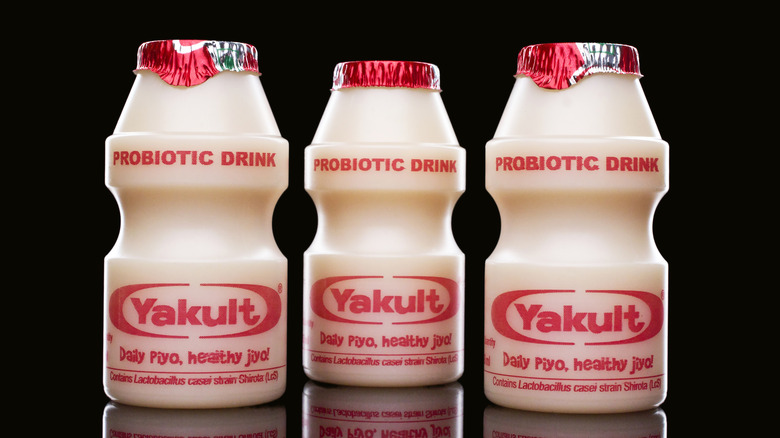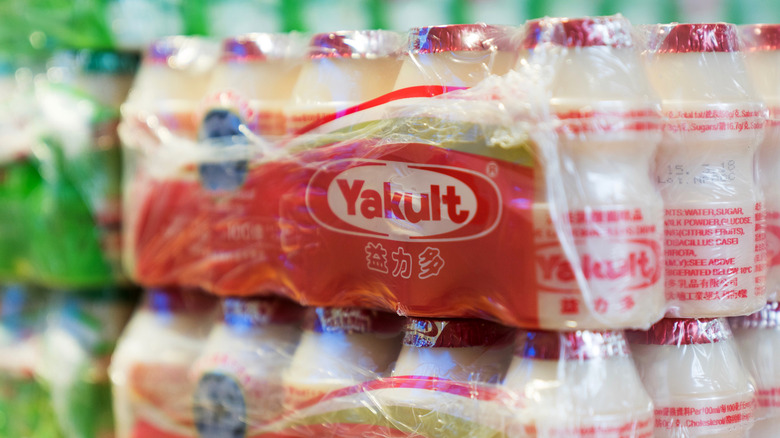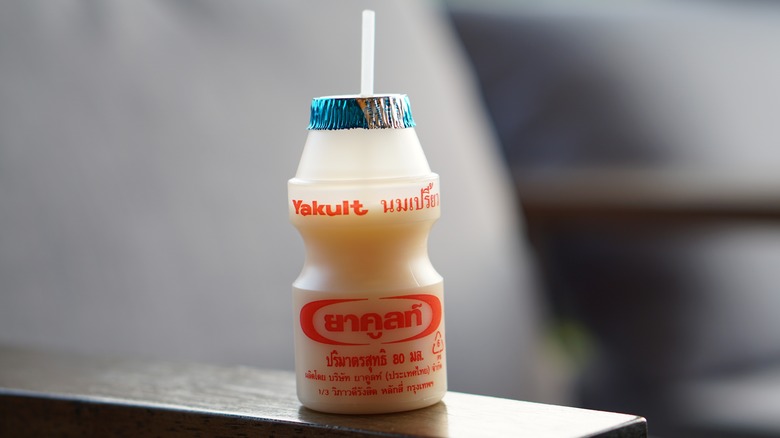Yakult Is The Ever-Popular Japanese Dairy Drink You Should Know About
In many ways, Yakult is the Japanese equivalent of the apple and grape juice boxes Western children sipped on in their youth. Packed in lunch boxes, served with breakfast, or enjoyed as a treat, Yakult is emblematic of childhood joy in many Asian countries. And though pitched as a beneficial probiotic drink, its overall health benefits are debatable since it's loaded with sugar. Yakult comes in an instantly recognizable row of five baby-sized bottles, plastic-sealed together. With its thin foil top, you can stick a tiny straw in it, punch a hole in it with your finger, or peel back the whole thing. More drink than yogurt, it could be described as a runnier version of dairy smoothies like Danimals, with a robust tartness found in more plain yogurts.
The dairy drink was invented by Dr. Minoru Shirota, who was determined to find a cure for cholera and dysentery, which were plaguing Japan at the time. Shirota found that lactic acid bacteria was an effective prevention for intestinal disease, so he isolated and included it in his probiotic beverage. Since it was first sold in 1935, the formula has changed gradually, but it still contains water, skimmed milk, glucose, sugar, and the Lactobacillus casei Shirota (Yakult's patented strain of lactic acid bacteria).
Yakult is basically a sweet, drinkable yogurt
Yakult starts with a basic solution of water that has been sterilized and purified of minerals. Mixed with skim milk powder, sugar, and dextrose, the solution becomes a milky liquid which makes the base for the drink. This solution is then pasteurized using the common method of high-temperature, short-term sterilization, or HTST, which involves heating and cooling down the solution rapidly. Afterward, the main ingredient, Lactobacillus casei Shirota, is added to the formula as a fermentation starter where the temperature is kept constant.
Once fermentation is complete, the resulting mixture is homogenized into a smoother consistency before the flavors and sugars are added. At this stage, the result is actually a thick yogurt, which is why it has to be diluted with more water before it's transferred into the bottles. While there are other diluted yogurt products on the market, Yakult's signature flavor makes it taste like no other beverage. And its added appeal as a digestive aid continues to make it allluring to customers — 8 billion Lactobacillus casei Shirota, in every tiny bottle.
How to drink Yakult
Yakult has branched out beyond the drink itself into a sort of empire. Now there are products that are specifically labeled Yakult-flavored, including soju (a popular Korean spirit), candy, ice cream, and even skincare. Thanks to its great popularity, Yakult can be enjoyed in many different ways. The classic way of sipping straight from the bottle is the best way to truly experience the beverage, but inventive ways to enjoy this probiotic drink have and will likely continue to emerge.
One popular way to enjoy them is to store bottles of Yakult in the freezer and enjoy them as mini popsicles. Simply slice open the bottle and lap up or crunch on the icy tart treat. Though the Yakult-flavored soju is now available in, the practice of using Yakult as a mixer preceded the product by many years. The sweet and fruity flavor of Yakult cuts through a clear drink like soju, smoothing over the burn of the spirit quite well. You can even go for a full-fledged cocktail by mixing a shot of soju with a bottle of Yakult and a douse of 7UP for a zesty, milky mixer.


